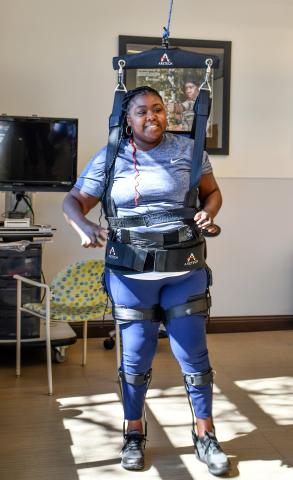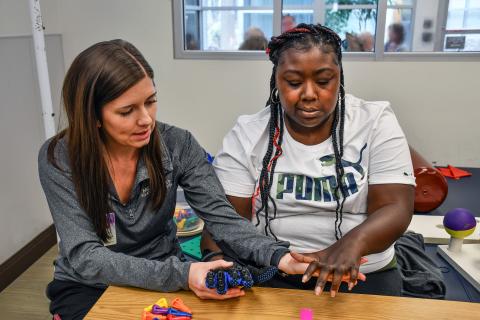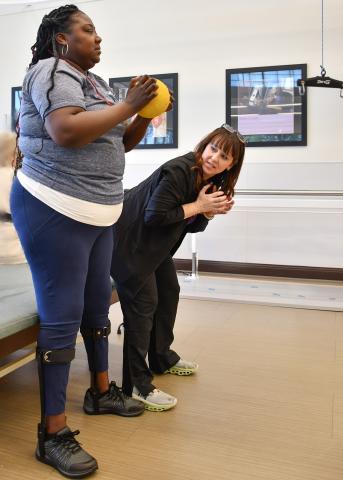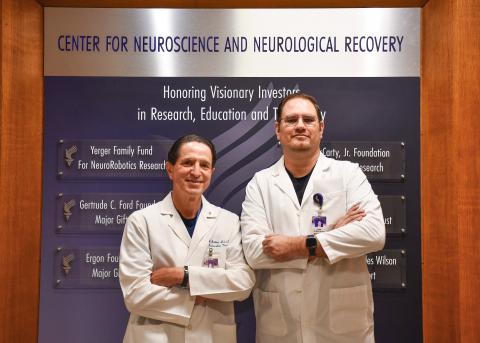Methodist Rehab researchers identify rare genetic disease behind Vicksburg woman’s paralysis




Kalisa Conley of Vicksburg lives with a long list of don’ts.
Don’t drink alcohol, smoke, take hormones, go on low-carb diets or fasts. Don’t take certain pain relievers, antibiotics or seizure medication. And don’t stress out or invite infections.
All are triggers for porphyria, a condition that nearly killed Conley before two Methodist Rehabilitation Center researchers identified the mysterious disease.
For some 15 years, doctors mistook Conley’s porphyria symptoms for more common ailments. They diagnosed her severe abdominal cramps as pancreatitis. Attributed her altered mental status to psychological problems. And blamed her oddly-colored urine on dehydration.
When she experienced extreme weakness in all four limbs, they thought she might have Guillain-Barre’ Syndrome (GBS). GBS causes a creeping paralysis that begins in the extremities and spreads. So Conley was sent to Dr. Art Leis for studies to gauge electrical activity in her muscles and nerves.
Leis is well acquainted with GBS in his role as a neurologist and physician-scientist at MRC. The Jackson hospital has long been a go-to resource for GBS patients, and most fully recover. But Conley didn’t fit the usual profile.
“She was so profoundly weak, including shortness of breath, that I expected her to die,” Leis said.
Leis and certified nerve conduction technologist Dr. Isvan Alvarez Herrera dove deeper into Conley’s case. And the results would change the direction of her treatment.
“What we noticed was a trend of recurrent abdominal pain attributed to pancreatitis and amber or burgundy urines over the years,” Leis said. “Credit goes to Isvan who recognized this pattern as possible porphyria.”
Porphyria afflicts fewer than 200,000 people in the United States. So it wasn’t surprising that Conley and her mom, Konola Conley, had never heard of it. But Leis said it’s hardly top of mind with doctors, either. “It’s something we read about in medical school … but most physicians never make that diagnosis in their lives,” he said.
“Most everybody misses it, and the patient can die because of interventions of the doctors,” Herrera said. That’s because they sometimes prescribe the same medications that porphyria patients are taught to avoid.
According to the American Porphyria Foundation, the inherited genetic disorder is linked to a malfunction in the body's production of heme. The complex molecule transports oxygen to the body’s cells. If any step in the synthesis is blocked, chemicals known as porphyrins accumulate in the cells. This causes a variety of problems. Indeed, porphyria is not one single disease, but a sub-group of eight related conditions that manifest differently.
In Herrera, Conley was fortunate to find someone who had long been fascinated by the rare disease. He first heard of it while in medical school in his native Cuba. “When I entered the field of neuromuscular disorders, there was a chapter on porphyria,” he said. Later, he would read a book by Chilean writer Isabel Allende, whose daughter, Paula, died from suspected porphyria.
“It was always there in the back of my mind that at some point in my life I would encounter a patient with porphyria,” he said. “Here, you have a lot of serendipity. I could have spent my whole life without seeing one, and a case came to me.”
Not only did Herrera recognize the symptoms of porphyria, he also knew an easy means to test the diagnosis. During an attack, a porphyria patient’s urine may be red to brown in natural light and pink to reddish purple in fluorescent light. The diagnosis can be confirmed via blood, urine, stool and genetic testing.
Sure enough, Conley tested positive. “I was glad to know what it was because I was scared,” she said.
“I didn’t let it stop me”
Looking back, Konola suspects her daughter’s first symptoms showed up at age 8 or 9. “She’d sit in her desk in class, and she couldn’t get up. She’d stumble for a minute. I had her checked out, but we couldn’t figure out what it could have been.”
In her late teens, Conley began suffering from stomach pain, vomiting and altered mental status. “But I didn’t let it stop me,” she said. “You just have to lay down sometime and let it do what it is going to do.”
Between attacks, Conley went at life full-tilt. She moved to Texas in 2017, where she worked overtime at her security job, fixed hair on her days off and opened a boutique with a friend.
Then came her worst episode ever. “It just put a halt on everything,” she said of an attack in November of 2021.
“New Year’s Eve, I brought her home,” said her mom. “She was walking, and by night she couldn’t get out of her chair. My son, Kenneth, is an EMT, and he said, ‘We are going to have to take her to the hospital.’”
Konola dreaded visiting the ER on New Year’s Day. “But when we came through the door, they were waiting on us,” she said. “The lady who took her blood pressure said, ‘Don’t worry, we got her. She’s not going to leave until she can walk out.’”
But it was not to be. Three months later, Conley rolled out, still dependent on a wheelchair.
Once Conley was correctly diagnosed with porphyria, she began treatment at the University of Mississippi Medical Center with the IV drug Hemin.
A couple of weeks after her treatment, Conley was deemed too weak for the rigors of inpatient rehab. “They said she needed to be a patient in a nursing home, and I said it’s not up to you,” Konola said. “I took her home in March 2022.”
It would not be the first time Konola’s mama bear tendencies saved the day. Leis believes it was Konola’s strong advocacy that kept her daughter from dying. But she had to stand down a bit once Conley did make it to rehab.
“I was that mom that did everything, and the therapists had to move me back. They said she needs to learn how.”
While Conley was eager to reclaim her life, she was still a frail shell of her former self.
“She essentially presented as a quadriplegic even though she didn’t have a spinal cord injury,” said Cameron Huff, a physical therapist at Methodist Outpatient Therapy in Flowood.
“She needed the assistance of two people just to get from her wheelchair to a mat. She was unable to roll over or go from sitting to lying down or vice versa without total assistance. She even needed close supervision to sit on the side of the mat.”
Because Conley had no strength against gravity, she was fortunate that Methodist Outpatient Therapy has two of the three ZeroG® Gait and Balance Systems in Mississippi. The device allows therapists to adjust the amount of weight born by patients as they practice walking.
In the beginning, Conley carried just 70 percent of her weight as she paced across the therapy gym with the support of the ZeroG overhead harness system and a platform walker.
Today, she walks by herself with no assistive devices other than lower leg braces to bolster her still immobile ankles.
“I don’t think anybody dreamed she’d progress to the point she has now,” Huff said. “She was a hard worker. She’ll try anything you ask her to do.”
A case in point is the work she does with Methodist occupational therapist Adrienne Brumfield. Porphyria left Conley’s fingers curled inward. So Brumfield has her perform hand exercises while wearing a futuristic looking SaeboFlex rehabilitation glove.
“She can grasp and open her hand, but she can’t straighten her fingers all the way because the small muscles in her hand are very weak,’ Brumfield said. “This glove helps her extend her fingers and helps her wrist stay neutral. It makes her grasp and release a lot more functional.”
“I never saw her crying, mad or upset”
Now 35, Conley can even do a little hair braiding again. It’s one more step toward the life of independence she craves.
To that end, she plans to begin therapy at Quest, a community reintegration program that’s part of Methodist Outpatient Therapy in Ridgeland. Quest helps people with brain, spinal and other neurological injuries make a successful return to work, school or community life.
Conley has hopes of pursuing a career in cyber security and not being so reliant on her mom. After months of sharing the same bedroom, her mother jokes: “We are about to kill each other now that she has gotten better.”
Konola says she’s proud of her daughter’s resilience during the years of crises. “I never saw her crying, mad or upset,” she said.
It helped that the Conleys were bolstered by the support of family, friends and the congregation of New Zion Missionary Baptist Church. “The deacons and preacher would run out of the door to get her in the building,” her mom said. “And my brother Ronald Turner, who just retired, came to stay every day with her in the hospital.”
The Conleys are also grateful for the health care workers who have guided Kalisa’s recovery, as well as the diagnostic skills of Leis and Herrera.
Herrera presented a case study about Conley at the annual American Association of Neuromuscular and Electrodiagnostic Medicine meeting in Nashville, where he earned Technologist Best Abstract Award.
Titled “A Nerve-Wrecking Journey to Porphyria,” the abstract traces Conley’s frustrating search for answers and makes an important point. She could have escaped years of misery if only someone had suspected porphyria and did a simple urine test.
According to recent studies, more than 70 percent of attacks are accompanied by darkening of the urine. Yet diagnoses remain delayed, a mean of 15 years in one study. Herrera’s long-term goal is to promote random urine testing for porphyria in patients admitted with GBS.
Going forward, Conley will have to be careful to avoid porphyria triggers and seek timely treatment when symptoms appear.
But her plan is to focus on the positives in her life. “I just want to start walking again, working again and mingling again,” she said.